Using the Elastic Beanstalk environment management console
The Elastic Beanstalk console provides an Environment overview page for you to manage each of your AWS Elastic Beanstalk environments. From the Environment overview page, you can manage your environment's configuration and perform common actions. These actions include restarting the web servers running in your environment, cloning your environment, or rebuilding your environment from scratch.
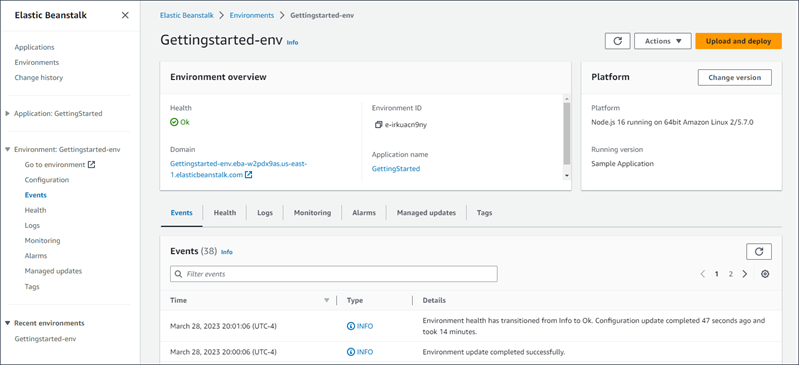
To access the environment management console
Open the Elastic Beanstalk console
, and in the Regions list, select your AWS Region. -
In the navigation pane, choose Environments, and then choose the name of your environment from the list.
Note
If you have many environments, use the search bar to filter the environment list.
You see the Environment overview page. The console's navigation pane shows the name of the application where the environment belongs, with related application management pages, and the environment name, with environment management pages.
Topics
Environment overview
To view the Environment overview page, choose the environment name on the navigation pane, if it's the current environment. Alternatively, navigate to the environment from the Applications page or from the main environment list on the Environments page.
The top pane on the environment overview page shows top-level information about your environment. This includes its name, URL, and current health status, as well as the name of the currently deployed application version, and the platform version that the application is running on. You can see the most recent environment events below the overview pane.
Choose Refresh to update the information shown. The overview page contains the following information and options.
Health
The overall health of the environment. If the health of your environment degrades, the View causes link displays next to the environment health. Select this link to view the Health tab with more details.

Domain
The environment's Domain, or URL, is located in the upper portion of the Environment overview page, below the environment's Health. This is the URL of the web application that the environment is running.
Environment id
The environment ID. This is an internal ID that's generated when the environment is created.
Application name
The name of the application that is deployed and running on your environment.
Running version
The name of the application version that is deployed and running on your environment. Choose Upload and deploy to upload a source bundle and deploy it to your environment. This option creates a new application version.
Platform
The name of the platform version running on your environment. Typically, this comprises the architecture, operating system (OS), language, and application server (collectively known as the platform branch), with a specific platform version number.
If your platform version is not the most recently available, then a status label displays next to it in the Platform section. The Update label indicates that although the platform version is supported a newer version is available. The platform version may also be labeled as Deprecated or Retired. Select Change version to update your platform branch to a newer version. For more information about the states of a platform version, see the Platform Branch section in the Elastic Beanstalk platforms glossary.

Environment overview tabs
The tabs displayed on the bottom half of the page contain more detailed information about your environment and provide access to additional features:
-
Events – Shows information or error messages from the Elastic Beanstalk service and from other services whose resources this environment uses.
-
Health – Shows the status of and detailed health information about the Amazon EC2 instances running your application.
-
Logs – Retrieve and download logs from the Amazon EC2 in your environment. You can retrieve full logs or recent activity. The retrieved logs are available for 15 minutes.
-
Monitoring – Shows statistics for the environment, such as average latency and CPU utilization.
-
Alarms – Shows the alarms that you configured for environment metrics. You can add, modify or delete alarms on this page.
-
Managed updates – Shows information about upcoming and completed managed platform updates and instance replacement.
-
Tags – Shows environment tags and allows you to manage them. Tags are key-value pairs that are applied to your environment.
Note
The navigation pane on the left side of the console lists links with the same name as the tabs. Selecting any of these links will display the contents of the corresponding tab.
Environment actions
The environment overview page contains an Actions menu that you can use to perform common operations on your environment. This menu is shown on the right side of the environment header next to the Create a new environment option.
Note
Some actions are only available under certain conditions, remaining disabled until the right conditions are met.
Load configuration
Load a previously saved configuration. Configurations are saved to your application and can be loaded by any associated environment. If you've made changes to your environment's configuration, you can load a saved configuration to undo those changes. You can also load a configuration that you saved from a different environment running the same application to propagate configuration changes between them.
Save configuration
Save the current configuration of your environment to your application. Before you make changes to your environment's configuration, save the current configuration so that you can roll back later, if needed. You can also apply a saved configuration when you launch a new environment.
Swap environment Domains (URLs)
Swap the CNAME of the current environment with a new environment. After a CNAME swap, all traffic to the application using the environment URL goes to the new environment. When you are ready to deploy a new version of your application, you can launch a separate environment under the new version. When the new environment is ready to start taking requests, perform a CNAME swap to start routing traffic to the new environment. Doing this doesn't interrupt your services. For more information, see Blue/Green deployments with Elastic Beanstalk.
Clone environment
Launch a new environment with the same configuration as your currently running environment.
Clone with latest platform
Clone your current environment with the latest version of the in-use Elastic Beanstalk platform. This option is available only when a newer version of the current environment's platform is available for use.
Abort current operation
Stop an in-progress environment update. Stopping an operation can cause some of the instances in your environment to be in a different state than others, depending on how far the operation progressed. This option is available only when your environment is being updated.
Restart app servers
Restart the web server that is running on your environment's instances. This option doesn't terminate or restart any AWS resources. If your environment is acting strangely in response to some bad requests, restarting the application server can restore functionality temporarily while you troubleshoot the root cause.
Rebuild environment
Terminate all resources in the running environment and build a new environment with the same settings. This operation takes several minutes, similar to the amount of time needed for deploying a new environment from scratch. Any Amazon RDS instances that are running in your environment's data tier are deleted during a rebuild. If you need the data, create a snapshot. You can create a snapshot manually in the RDS console or configure your data tier's Deletion Policy to create a snapshot automatically before deleting the instance. This is the default setting when you create a data tier.
Terminate environment
Terminate all resources in the running environment and remove the environment from the application. If you have an RDS instance that is running in a
data tier and you need to retain its data, make sure the database deletion policy is set to either Snapshot or
Retain. For more information, see Database lifecycle in the
Configuring environments chapter of this guide.
Restore environment
If the environment has been terminated in the last hour, you can restore it from this page. After an hour, you can restore it from the application overview page.
Events
The Events tab shows the event stream for your environment. Elastic Beanstalk outputs event messages whenever you interact with the environment, and when any of your environment's resources are created or modified as a result.

For more information, see Viewing an Elastic Beanstalk environment's event stream.
Health
If enhanced health monitoring is enabled this page shows live health information for your instances. The Overall health pane shows health data as an average for all of your environment’s instances combined. The Enhanced instance health pane shows live health information for each individual instance in your environment. Enhanced health monitoring enables Elastic Beanstalk to closely monitor the resources in your environment so that it can assess the health of your application more accurately.
When enhanced health monitoring is enabled, this page shows information about the requests served by the instances in your environment and metrics from the operating system, including latency, load, and CPU utilization.
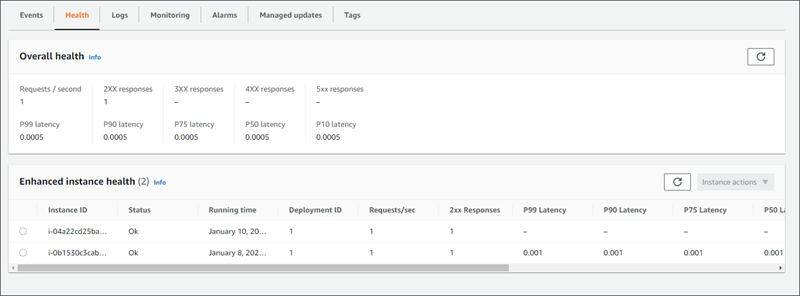
For more information, see Enhanced health reporting and monitoring.
Logs
The Logs page lets you retrieve logs from the EC2 instances in your environment. When you request logs, Elastic Beanstalk sends a command to the instances, which then upload logs to your Elastic Beanstalk storage bucket in Amazon S3. When you request logs on this page, Elastic Beanstalk automatically deletes them from Amazon S3 after 15 minutes.
You can also configure your environment's instances to upload logs to Amazon S3 for permanent storage after they have been rotated locally.
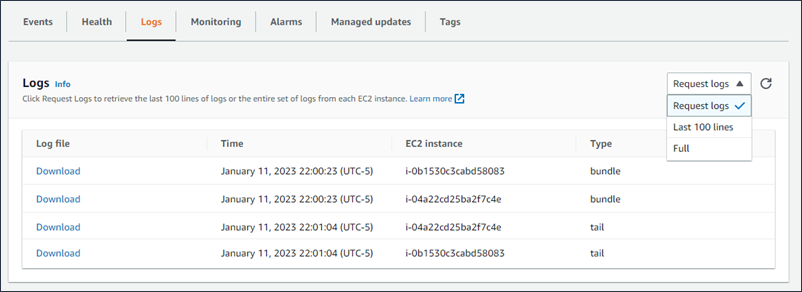
For more information, see Viewing logs from Amazon EC2 instances in your Elastic Beanstalk environment.
Monitoring
The Monitoring page shows an overview of health information for your environment. This includes the default set of metrics provided by Elastic Load Balancing and Amazon EC2, and graphs that show how the environment's health has changed over time.

For more information, see Monitoring environment health in the AWS management console.
Alarms
The Existing alarms page shows information about any alarms that you have configured for your environment. You can use the options on this page to create or delete alarms.

For more information, see Manage alarms.
Managed updates
The Managed updates overview page shows information about upcoming and completed managed platform updates and instance replacement.
The managed update feature lets you configure your environment to update to the latest platform version automatically during a weekly maintenance window that you choose. In between platform releases, you can choose to have your environment replace all of its Amazon EC2 instances during the maintenance window. This can alleviate issues that occur when your application runs for extended periods of time.
For more information, see Managed platform updates.
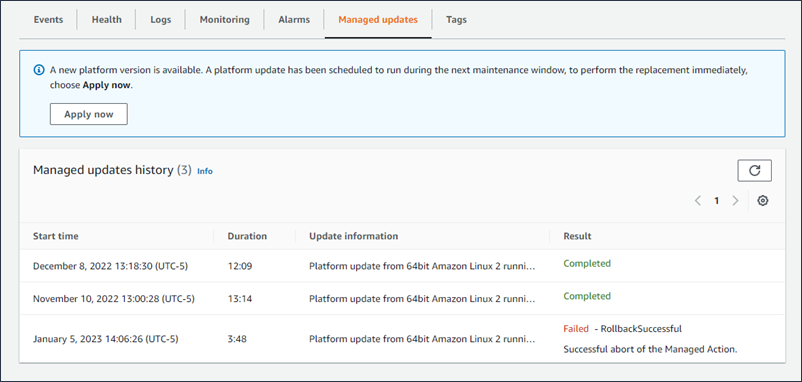
For more information, see Managed platform updates.
Tags
The Tags page shows the tags that Elastic Beanstalk applied to the environment when you created it, and any tags that you added. You can add, edit, and delete custom tags. You can't edit or delete the tags that Elastic Beanstalk applied.
Environment tags are applied to every resource that Elastic Beanstalk creates to support your application.

For more information, see Tagging resources in your Elastic Beanstalk environments.
Configuration
The Configuration page shows the current configuration of your environment and its resources, including Amazon EC2 instances, a load balancer, notifications, and health monitoring settings. Use the settings on this page to customize the behavior of your environment during deployments, enable additional features, and modify the instance type and other settings that you chose during environment creation.
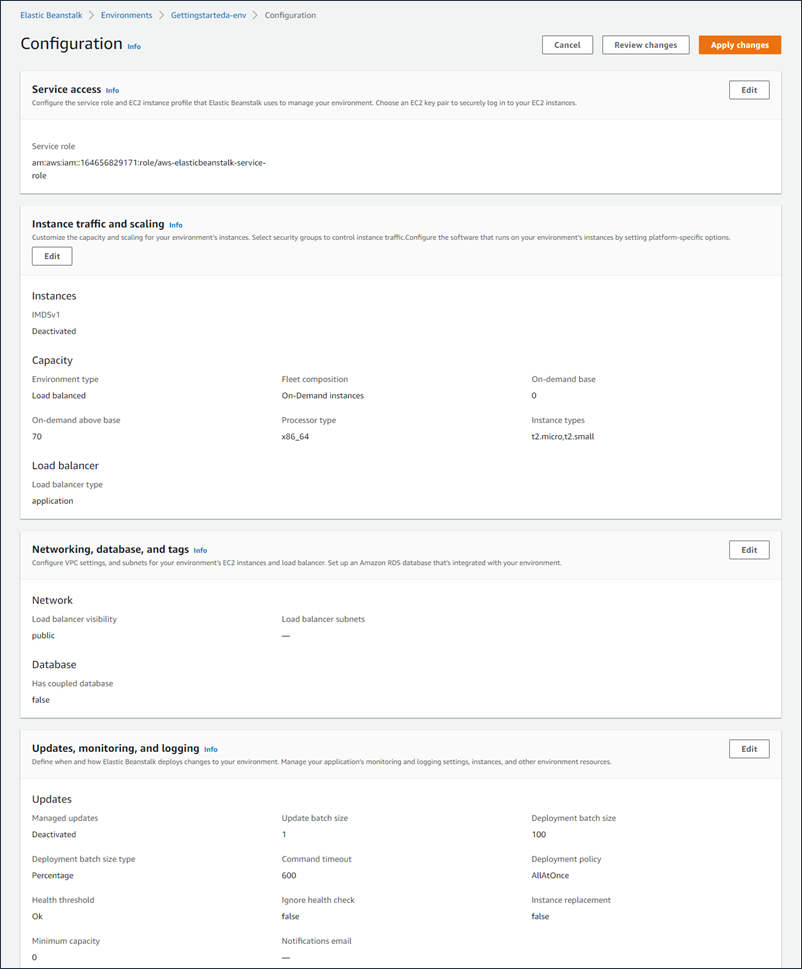
For more information, see Configuring Elastic Beanstalk environments.